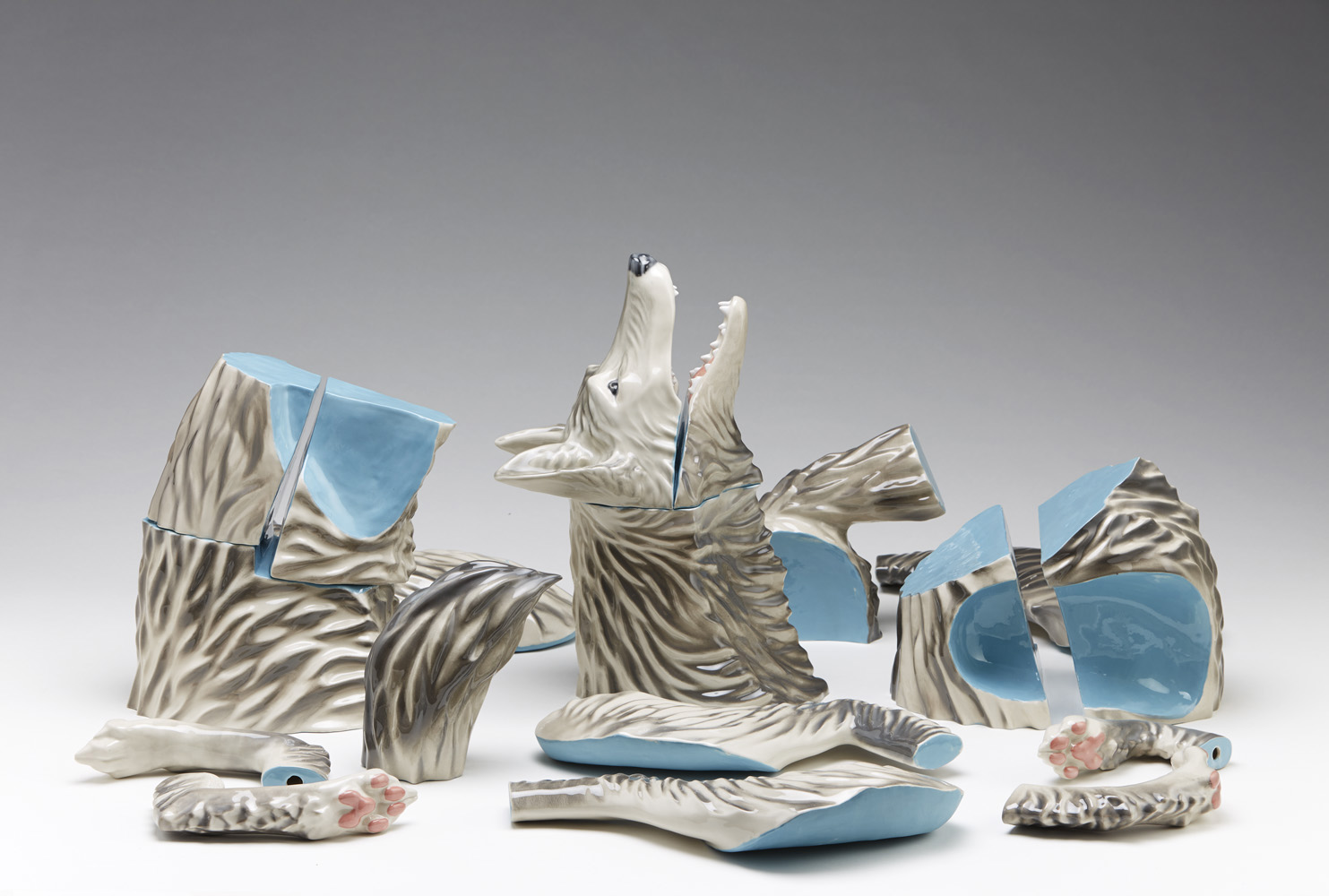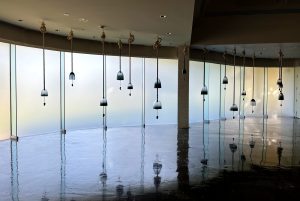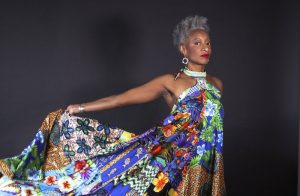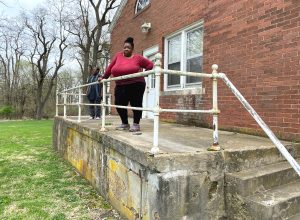Emmy Lingscheit is a visual artist and Associate Professor at the University of Illinois at Urbana-Champaign. Lingscheit’s work can broadly be characterized by attention to detail: in formal qualities such as color selection, choice of text, and the intricacies of mark-making, but also in the choice of subject matter. Her work addresses the human condition by looking at the systems we create to govern our lives, calling into question the ways in which social and cultural justices are not compatible with such systems. She interrogates these systems, particularly environmental ones, to understand how the ways we “otherize” the natural world is directly related to the ways we “otherize” people, marking both as exploitable and disposable.
One strategy Lingscheit employs is drawing the viewer in with technical savvy and grace; her work is gorgeous. The repetition of marks and imagery hypnotize the viewer so much so that looking at her work is analogous to the ways in which we are swept up in these systems. Though there is a sense of wanting to spend more time with her work to explore every single detail, there is never a sense of feeling patronized or dismissed, as one might in the capitalist and patriarchal systems we occupy. There is always a sense of discovery, and as a viewer, I left asking myself how I am implicated in these matters.
I spoke with Lingscheit via Zoom at the very end of June, in a summer marked by calls for racial justice and drastic changes to the systems that govern our lives. We talked about her path to printmaking, engaging with theories of disruption as well as the disruption of the COVID-19 global pandemic, and how art can be used for social change.
This interview has been edited for length and clarity.
Jessica Hammie: Did you have any formative experiences growing up that led you to art-making?
Emmy Lingscheit: I was really lucky for a school in South Dakota to have a set of three different, really dynamic, cool teachers from early on in high school. I was an art nerd, like really, really deep.
JH: Did your high school have an art club?
EL: Yes. Oh, and I was a member. The art club was a kind of de facto LGBT and allies group.
JH: They always are! Especially in the 90s.
EL: Yeah, and now looking back, you could see that was clearly what was at work—you know, queer art kid, typical story. Beyond that my family was pretty supportive. My sister is also an artist and we would draw monsters on Post It notes. That was kind of demonstrative of the power of drawing and invention, and that you could imagine these entire worlds and creatures and systems that didn’t exist. It just felt very magical and empowering. As I passed through school and was approaching college I knew that [art] was still something I wanted to do despite the many other pressures—earning a living, the doubts that were pressed upon me from the adults in my life.

JH: What did you think you would do coming out of undergrad?
EL: I was pretty sure that I wanted to be done with school for a while. I thought that I would do graduate school at some point, but I was pretty happy to work a 40-hour-a-week job to pay rent. I lived in Minneapolis at the time, which [has a] really supportive community for the arts. There’s a lot of funding available, particularly for emerging artists, and that was a time when I had the support of some [St. Cloud State University] faculty members. I did not want to move back to western South Dakota, where I was from.
My two housemates and I had a little printmaking press that we used to make works at home, and with those, I applied to a Jerome Emerging Printmakers Residency at the Highpoint Center for Printmaking. That was the first time I took myself seriously as an independent artist. I think up until that point I was a student fulfilling assignments and developing some direction towards the subjects that I was interested in, but this was the first time that I had nine months of studio access, visits with critics, and an expectation that I was going to produce a body of work. The pressure and opportunity provided an environment to flourish and to figure out if this was a thing that was sustainable for me, and [if] I could see a future that led me to those opportunities I had at the Highpoint.
The body [of work] that came out of that led me to enter this community of printmakers, of workshops and conferences and festivals where I [got] to actually know people who taught [and] were graduate students, and it opened up this whole world of possibilities that I had known about in name only. I was out of school for probably four to five years [before] I knew that I needed to either [go to grad school] or life might pass me by.

JH: You majored in painting as an undergrad, right?
EL: Um-hmm. What else was there? [Laughs]
JH: And then you came to printmaking through this residency?
EL: During my four years at St. Cloud State I took two printmaking classes. That was where I felt like I found my people. In the printmaking studios [there was] this congregation of students talking to each other and hanging out, working, and trying to figure out how to unclog the graining sink in the middle of the night so we could get our homework done for the next day. That was really something that I craved, that kind of community.
I found [printmaking] to be a better fit for the way that I work. I have a penchant for very detailed drawing; that is a bit more of a printmaker’s hallmark. The iterative process of working in printmaking was very cool because the outcome of your product, of your work, is determined by the actions you’re taking along the way. Nothing is predetermined and you’re making a lot of adjustments and innovations in response to the materials because it’s this layered process.
JH: I guess [painting] can be communal, but at the end of the day, it’s your studio, and with printmaking, you have a shop. Has that informed how you think about art-making?
EL: Yeah, for sure. I think that the experience that I had coming up through undergrad and grad school and various opportunities in print shops is something that I am continuing to have a role in as a faculty member, which is interesting and super rewarding to this give and take—that it’s not a top-down approach. There are obviously learning strategies and discoveries that are moving back and forth between the so-called master and the student. I’m in the same print shop with students of all levels for extended periods of time. The students I work with are from all different backgrounds and experiences and economic levels.
I do think that there’s a connection between that kind of communal working and a little bit of a social awareness beyond what [the studio] class is strictly related to. You can’t ignore policies and Supreme Court decisions and all these other things. That social awareness goes hand in hand. There’s a long tradition of social justice in printmaking, too; a lot of revolutionary image-making.
JH: It’s been a month since George Floyd was murdered, and with all these protests and marches that have popped up, you have made some prints for those—I’m guessing to be used in these marches. Can you talk about that a little bit?

EL: [Considering] the number of atrocities that have been caught on video [and the] amount of similar occurrences that have been happening out of view of cameras for time immemorial, it’s undeniable that our country has these systemic problems. In the wake of this, also having a connection to Minneapolis and many friends who were participating on the ground, I was feeling helpless and in pain about the situation and wanting to participate from a distance. At that point, things were only beginning to seed into other towns and communities. I wanted to get into the studio and just make something. The fastest, most cathartic thing to do was to slam some type together, so I just tried to find the right turns of phrase to try to express what I wanted to say succinctly—and what I felt a lot of people wanted to say—and get it out there for the purpose of getting it out there. People could carry and amplify these messages, but [I could] also raise funds for some of the organizations in Minneapolis that were supporting social justice and George Floyd’s family. I had people send screenshots of donations they made and then mailed them prints in exchange, which was quite successful. I was surprised by how many prints I was able to mail and the money that we raised. That felt good.
JH: This also makes me think of the project that you had your students do—I don’t know if you do it every semester—redesigning the Illinois mascot [The Chief was officially retired in 2007]. Can you tell me a little bit about that?
EL: The Chief [is] this enduring image that [the University of Illinois] cannot seem to set aside. I think there are some real reasons that people have trouble letting it go that have to do with the aesthetic appeal. I think that there [are] others that have to do with not wanting to alienate that good donor money, that these people feel very strongly that the Chief is part of their identity [and] inseparable from their experience at the [university]. Even though it’s hurtful and has been requested to be retired by Native people, there hasn’t been enough effort to try to find a viable substitute.
I feel like that’s a real opportunity. It’s one of the places where art has value. Art has a social place and can drive change by illustrating and making visible some of the concepts that we want to embody as a [university]. Asking students to imagine a better future, or a better symbol in this case, [is] also educating them as to the history of the mascot. We read materials and watch documentaries about it, and a lot of [the students] are not aware of that history. It makes them think a little bit more deeply about those things, about their opportunities to engage with the world for positive change.
JH: How would you describe your practice and your research?
EL: My work is interested in the interconnectedness of human activity and the natural world, and how some of the things that we take for granted are much more nuanced and complicated and strange than we perceive them to be, that systems and bodies are much more intertwined and enmeshed with each other than we think. My work is often influenced by the landscape that I’m in. Moving to Illinois has made [me] a little more interested in the local ecology and use of the land for industrial farming and for large-scale monoculture. You go outside of this idyllic tree covered town and it’s just acres of soybeans and corn as far as the eye can see. I think that is really fascinating, the way we’ve manipulated the environment both intentionally and unintentionally.
My work aims to look at the ways we treat the natural world as this sort of “other” that we’re separate from [and how that] also influences the ways that we view other people as potentially disposable, expendable, or there for our exploitation. My work had been about post-naturalism and ecological justice, and more and more I’m trying to find ways to visually acknowledge and recognize the ways that social justice and the ecological concerns are very intertwined and inseparable.

JH: You describe your influences as environmental and social justice as you just mentioned, but also queer theory and speculative fiction. Can you speak to that a little bit?
EL: I’m interested in ways of resisting the dominant, cis, white, hetero, patriarchal structures I’ve been finely attuned to and I chafe against. I am really intrigued by ways that authors and artists can open up and attune people’s imaginations to other possibilities, other ways of living, [and] resistance to the monoculture that debate and adapt, go forward, and change regardless, and sometimes more strongly, in response to efforts to crush them out.
JH: Queer theory and speculative fiction are disruptors.
EL: Capitalist systems are something that I should mention there, too, because I think there is a short-sightedness that nobody’s really quite willing to acknowledge. Things can’t grow infinitely—they really just can’t. There’s a mass delusion that we all subscribe to even against the very evidence of our own eyes every day, in the news about shrinking Amazon rain forests and even the coronavirus. There are direct correlations between the economy and the things that we’re doing with clear-cutting forests that are unleashing these new pathogens. There’s got to be some kind of reckoning and some equilibrium, and recognizing some alternatives to these dogmas that we all blindly follow. It’s really hard to change a system, but I think those disruptors are super important to queue into and try to amplify and support.
How to do that in art is the question.
JH: It’s engaging with these theories and using them as a framework on which you can build out your own research and your own body of work.
EL: I’m increasingly interested in moving away from wall-based pieces. There is this potential for printmaking to mass up into installations and immersive environments and site-specific works. I’m more and more interested in exploring that.

JH: Do you want to talk about that?
EL: Sure, yeah. Before the pandemic, I installed a couple of works for shows that involved a three-foot by two-foot linocut. I wheat-pasted up on the wall in repeating patterns these networks of fungi and other organisms that are known to create interconnected rhizomatic, micro-rhizal networks that connect entire forests, can exchange nutrients and sugars back and forth with trees, and help trees communicate with each other against invaders and pathogens. I was interested in this as one example of the ways we think of ourselves as the only supreme communicators and purpose-driven creatures on this earth.
That installation incorporated images of jellyfish. The visual resonance of those two things at the same scale was meant to queue into this teeming biological strangeness and world-out-of-balance that we’re witnessing right now in the form of jellyfish plumes. Massive overproduction of jellyfish will happen in areas with the ocean is kind of acidified from carbon build up and there have been documented cases in which they’ve clogged the intakes for nuclear cooling towers and caused fishing boats to capsize to when they pulled up a catch of just all solid, jellied sea. A creature that we see as brainless can be such a disruption and such a signal of problems.
Residencies have been a really big part of my ongoing education and development. Those are often where I get the most progress in bodies of work and leaps forward in breakthroughs and things I hadn’t thought of doing before.
JH: Can you tell me a little about your time at Kohler, when you did the John Michael Kohler Arts Center Arts/Industry Residency?
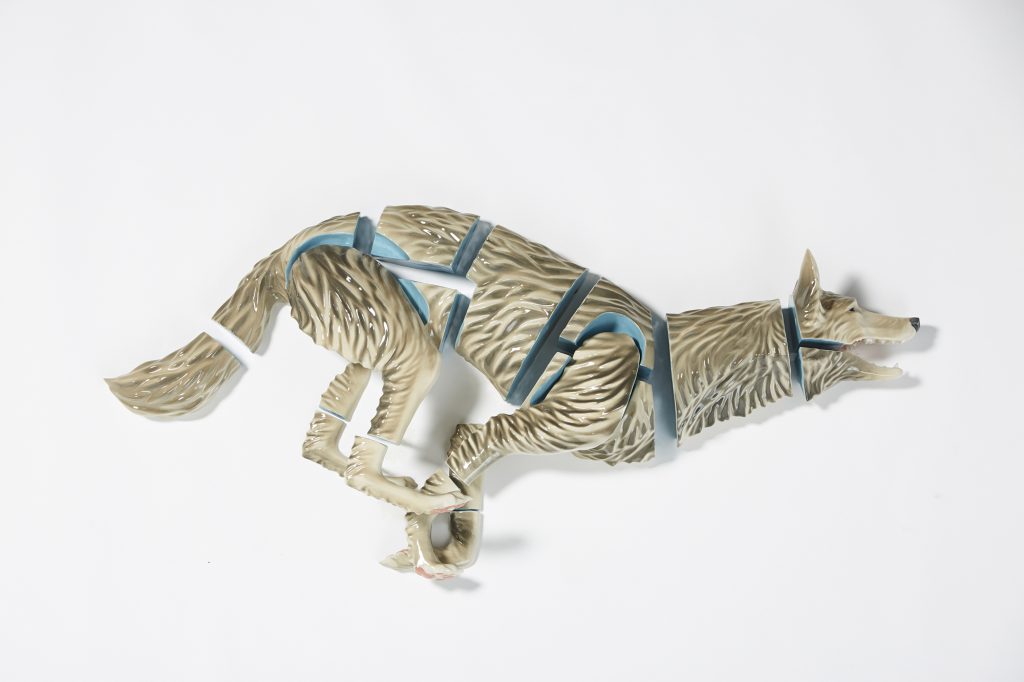
EL: Oh, yeah. That was amazing. It was in 2015 and I was super fortunate. I think that I had a very full idea already of what I wanted to do worked to my advantage in the selection process.
At Kohler I had three months studio access and my intention was to complete a project that was inspired by a print series I made called The Animal Deconstructions, which [featured] animals that live in close proximity with humans that were fleeing the picture plane and dissolving into puzzle pieces as they evaded human infrastructure and contact.
The Kohler residency gives you access to the materials that they have traditionally made sinks and tubs out of, and so I got to use those materials to make these life-sized coyotes. I picked the coyote population of Chicago as a subject—which is estimated to be about 2,000 or so animals that live right in the city—raise litters of pups in freeway loops and are able to find food and do what they need to do, basically undetected by humans.
The animal that I made at Kohler was nine different molds. For the first month, I made clay prototypes of each piece. The second I poured plaster molds. The third was casting. It was one of the more intense experiences of my life in terms of physical exertion and learning. I learned so much from just pure necessity. There were people around willing to tutor me a little bit, but you, as the artist, are doing all the physical labor.
It ended up being very successful—more so than I expected. What the material was capable of was really well matched to my vision. I made about nine coyotes in full body. They hang on the walls and they can be reconfigured in space each time. The way that they had to be segmented up in these molds ended up working conceptually well with the way these coyote populations in Chicago are actually sequestered and quarantined apart from each other by the built environment. Over time and intra-breeding [they have] become genetically distinct subgroups from one another. The ways in which human design has inadvertently designed other species is something that I’m fascinated with and points to other ways that we choose to spend resources and attention conserving, which is typically the more charismatic species like the Monarch butterflies or polar bears.
JH: The cute ones.
EL: Meanwhile, a thousand beetles go extinct in a day or something.
Featured Image: Image: Emmy Lingscheit, Canis Latrans Subdivision I, cast vitreous china, glaze, dimensions variable, 2015. A sculpture of a wolf, disassembled, is pictured in what appears to be eleven parts, viewed from the side. The wolf’s head is in the center of the image, nose pointed skyward. The fur of the wolf is glazed in brown-gray and whites. The areas of the sculpture that should be touching are glazed in blue. Areas of pink are visible on the paw pads and tongue. Photo courtesy of Emmy Lingscheit.


Jessica Hammie is a writer based in Champaign, Illinois. She is interested in the ways in which artists visualize identity, and how we come to understand our histories. In addition to writing for Sixty, Jessica is a Managing Editor at Smile Politely, a Champaign-based culture magazine.
